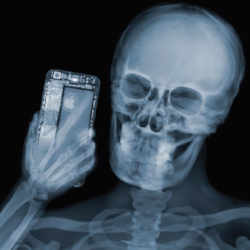
Enabling humans to see through physical objects has long been the stuff of science fiction novels, comic books, and films. While X-rays serve as a valuable tool for medical diagnosis and body scanners, and x-ray scanners are now widely deployed at airports for security, genuine X-ray vision could profoundly change the way we see the world.
In fact, scientists are on the path to making X-ray vision a reality. In February, a group from the Massachusetts Institute of Technology (MIT) introduced an augmented reality (AR) headset that generates holograms to guide a person to hidden radio frequency (RF) tagged objects. The X-AR headset can direct a user to a hidden object within 9.8 centimeters, with about 99% accuracy.
"RFID and other methods are already used to locate objects, but adding augmented vision is transformative," according to Fadel Adib, an associate professor and founding director of the Signal Kinetics group at MIT. "There are a vast array of real-world challenges X-ray vision can solve, including in manufacturing, warehousing, and even aiding people who are visually impaired."
Beyond the Surface
X-ray technology, which has been around for well over a century, has mostly been relegated to specific tasks and places, such as a doctor's office or an airport luggage scanner. The Machines are typically large and cumbersome, and there are often concerns about the health effects of X-rays, a form of ionizing radiation that can damage DNA and potentially cause cancer in humans and animals.
Yet a wave of advancements, which include the Internet of Things (IoT) and artificial intelligence (AI), are suddenly refocusing and reshaping the field. X-ray vision systems do not rely on conventional X-ray technology, harnessing instead other parts of the electromagnetic spectrum to see through physical barriers.
For example, a Seattle company, ThruWave Inc., has developed an X-ray vision system that uses high-speed 3D millimeter wave (mmWave) imaging to peer into corrugated boxes, plastic totes, and other containers. It detects anomalies in manufactured goods, counts items inside sealed packages, detects missing or damaged items, and finds other issues without any negative impact to human tissue. The system is used by soft drink bottlers and other manufacturers to boost quality control.
"Integrating these types of sensors and systems into manufacturing processes offers benefits, whether it's related to quality control or finding objects hidden in environments where it is difficult to differentiate them," says Matt Reynolds, chief scientist and co-founder of ThruWave and an associate professor in the Department of Electrical and Computer Engineering at the University of Washington.
The MIT researchers hope to take to take X-ray vision to a deeper level. "An AR headset is ideal for finding objects in certain situations, such as a large warehouse with tens of thousands of often similar items," says Tara Boroushaki, a Ph.D. candidate who is part of the team. In addition, "X-Ray vision could aid in finding missing objects at home and it could help the visually impaired detect objects as they move around," she says.
A New View
The X-AR headset views hidden objects that emit RF signals from RFID tags or other IoT devices. The framework uses synthetic aperture radar (SAR), which loosely mimics the systems airplanes use to identify movement and shapes. As a person wearing the headset moves around, the system coordinates and calculates the probability that a particular tag is a known object.
Once a user picks up the object, the system confirms the RFID tag and uses hand motion data to verify the authenticity of the object. An image of the item, along with a description of it, appear on the AR display. "With headset localization data and SAR wireless sensing, we can obtain very precise information," says Maisy Lam, another Ph.D. candidate who is part of the team.
The end result is a 3D map of a space and the tagged objects. "The localization accuracy achieved by this system would normally require large antenna arrays and a form factor that wouldn't be wearable," explains Aline Eid, an assistant professor of electrical engineering and computer science at the University of Michigan, and a former member of the research group.
The MIT team considers the prototype AR headset system to be a starting point; it is now experimenting with different sensing technologies that could improve imaging, including Wi-Fi, mmWave, and terahertz waves.
Meanwhile, Adib has launched a startup, Cartesian Systems, which develops mixed reality environments for indoor spaces. He says X-ray vision may soon extend to smartphones and other devices.
As X-ray vision technology advances, it may pose some risks, including an ability to see inside houses or under clothing, Adib admits. As a result, future X-ray vision systems might require some type of blocking or jamming technology, or a toggle switch that permits X-ray vision only when and where it's needed, he says. Reynolds believes authentication and encryption tools can keep data secure and private.
To be sure, X-ray sight is poised to become more than a vision in the years ahead. The ability to peer into the nooks and crannies that reach beyond human eyes could profoundly change the way we see the world. Concludes Adib: "We are hoping to move beyond the five senses and enter the realm of superhuman vision."
Samuel Greengard is an author and journalist based in West Linn, OR, USA.



Join the Discussion (0)
Become a Member or Sign In to Post a Comment